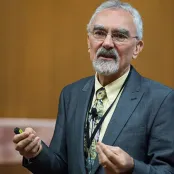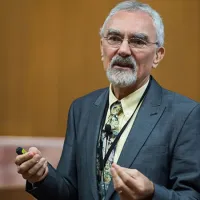A Southampton researcher is working to ensure that as many people as possible will benefit from next-generation communications.
Electronics and computer science expert Professor Lajos Hanzo is part of a team working on techniques to enable the 6G network - the super-fast successor to 5G.
It will integrate satellites, planes, drones and underwater nodes with the terrestrial 5G network, and provide coverage in previously hard to reach areas.
“5G wireless systems are still ground-based, so they have the same coverage limitations as other terrestrial networks,” says Lajos.
“Space-communication networks are complementary to terrestrial networks. They provide vast communication coverage for people and vehicles at sea, as well as in remote rural areas and in the air.”
6G will provide super-fast download speeds and instant connectivity wherever you are in the world.
Wealth creation benefits
Mining, smart farming, shipping and tracking will see significant benefits. As will rural and remote areas that have missed out on the wealth creation benefits of broadband.
Creating this space air-ground integrated network (SAGIN) is essential for 'vertical industries' such as logistics, mining, agriculture, fisheries and defence.
“SAGIN is expected to be at the core of 6G communication systems. How to build a high-capacity yet low-cost system is of significant importance in developing 6G globally,” says Lajos.
Technological challenges
There are many technological challenges to overcome, including the limited efficiency of direct communications between airborne and ground-based network elements.
Lajos and his team plan to use the existing civil airliner network.
“The civil airliner network covers a large area of the global land and sea surface. It has sufficient plane density to be a major contributor of a dynamic airborne network."
According to flight-tracking data company FlightAware, there are tens of thousands of planes in the sky at any given time.
These planes cover most of the land and sea globally, so can provide networking services supported by the SAGIN with vast coverage day and night.
In addition, because these airborne platforms are only about 10km above the ground, the coverage area of a signal beam can be well controlled.
Vast low-cost coverage
Lajos is excited at the prospect: “The proposed integration of spaceborne and airborne networks with ground-based networks is capable of improving the global communication coverage, which is the main objective of 6G networks.”
The main obstacle for rural broadband deployment has been the high cost of ground-based infrastructure. The proposed SAGIN offers vast coverage at low cost, bringing smart mining, farming and precision-agriculture technologies to remote areas.
Low-cost global connectivity will also allow enable detailed tracking of shipping containers and livestock.
The team is being funded by a €2.5m European Research Council (ERC) grant.







